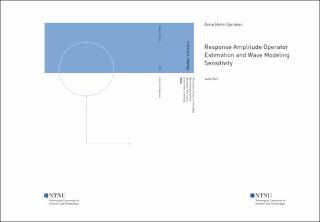| dc.description.abstract | Informasjon om sjøtilstanden og Respons Amplitude Operator (RAO) er viktig for å studere bevegelsene til flytende strukturer. Responsprediksjoner i marine operasjoner er ofte avhengige av bølgespektrummodeller basert på statistiske bølgeparametere gitt av værprognoser for å beskrive havmiljøet. Valget av bølgespektrum avhenger imidlertid blant annet av fartøyets geografiske beliggenhet, bølgesystemet, og bølgeparameterne. Videre blir RAOer vanligvis beregnet basert på lineær teori ved hjelp av numeriske metoder. Som et resultat av den økte tilgjengeligheten av responsmålinger i den maritime industrien, kan mer detaljerte RAO estimat oppnås ved å bruke målinger for å fange opp ulineære effekter i den bølgeinduserte responsen for høyere sjøtilstander. Fokus på en forbedret representasjon av sjøtilstanden og fartøyegenskapene kan gi betydelige fordeler når det gjelder sikkerheten ombord på fartøy og kostnader ved en operasjon på grunn av økt nøyaktighet i responsprediksjoner.
Målet i denne oppgaven var å forbedre prediksjonsnøyaktigheten av fartøyresponser gjennom en sensitivitetsstudie og RAO-estimering. En sensitivitetsstudie av responsprediksjon til bølgemodellering ble utført på fullskala data fra et konstruksjonsfartøy. Den teoretiske responsen ble beregnet ved å bruke de numerisk beregnede RAOene, og JONSWAP-, PM- og Ochi-Hubble-spektrene modellert basert på bølgeparametere fra værprognoser. Studien viste at responsen var sensitiv for de usikre elementene i forholdet mellom de prognostiserte parameterne for totalbølgen og vind- og dønning komponentene. Videre var ingen av de vurderte bølgespektrummodellene i stand til å tilfredsstillende gjengi alle målingene til tross for små variasjoner i sjøtilstandene. I tillegg er det foreslått to metoder for å estimere RAOene til et fartøy, basert på responsmålinger og et kjent bølgespektrum. Tuning-algoritmen optimaliserer en tuning-koeffisient for å forbedre et initielt estimat av RAOene. I motsetning er observer-algoritmen basert på en brute-force-metode for estimering av sjøtilstander som ikke krever noe tidligere estimat av RAOene. Metodene ble evaluert på data samlet ved Laboratoriet for Marin Kybernetikk (MC Lab) i Trondheim for Cybership Inocean Cat I Drillship (CSAD). De individuelle estimatene for hver modelltest ble brukt til å beregne gjennomsnittlige RAOer med hensyn til intervall av signifikante bølgehøyder. På grunn av et begrenset datasett med bølgeenergier distribuert for frekvenser der det forventes at bølgeindusert respons er lav, viste resultatene at de estimerte RAOene ikke gjenspeiler fartøyets sanne fysikk. Videre viste de gjennomsnittlige RAOene en klar avhengighet av de individuelle responsestimatene som følge av et begrenset antall tester. Imidlertid så man god overensstemmelse når de gjennomsnittlige RAOene ble brukt til å predikere fartøyets respons for to sjøtilstander, til tross for de urealistiske RAO-estimatene. | |
| dc.description.abstract | Information about the sea state and the Response Amplitude Operator (RAO) are essential in studying the motions of floating structures. Response predictions in marine operations often rely on wave spectrum models based on statistical wave parameters provided by forecasts to describe the ocean environment. However, the choice of wave spectrum depends, among other things, on the geographical location of the vessel, the on-site wave system, and the wave parameters. Further, the RAOs are typically calculated based on linear theory by numerical methods. As a result of the increased availability of response measurements in the maritime industry, more detailed estimates of the RAOs can be obtained by utilizing measurements to capture nonlinear effects in the wave-induced response for more severe sea states. A focus on an improved representation of the sea state and vessel characteristics can provide significant benefits in terms of the safety onboard vessels and costs of an operation due to increased accuracy in response predictions.
In this thesis, the aim was to improve the prediction accuracy of vessel responses through a sensitivity study and RAO estimation. A sensitivity study of response predictions to wave modeling was conducted on full-scale data of a construction vessel. The theoretical response was calculated by utilizing the numerically calculated RAOs, and JONSWAP-, PM-, and Ochi-Hubble spectra modeled based on wave parameters from weather forecasts. The study showed that the response was sensitive to uncertainty elements of the relation between the forecasted parameters for the total wave and the wind-wave and swell components. Further, none of the considered wave spectrum models enabled to satisfactorily reproduce the measurements for all samples despite minor variations in the sea states. Additionally, two methods for estimating the RAOs of a vessel have been proposed, based on response measurements and a known wave spectrum. The tuning algorithm optimizes a tuning coefficient to improve an initial estimate of the RAOs. In contrast, the observer algorithm is based on a brute-force method for sea state estimation that requires no prior estimate of the RAOs. The methods were evaluated on data gathered at the Marine Cybernetics Laboratory (MC Lab) in Trondheim for Cybership Inocean Cat I Drillship (CSAD). The sample-specific estimates from the dataset were utilized to calculate average RAOs with respect to the significant wave height. Due to a limited dataset with wave energies distributed for frequencies where the wave-induced response is expected to be low, the results showed that the estimated RAOs do not reflect the true physics of the vessel. Further, the average RAOs showed a clear dependence on the individually estimated responses due to few samples. However, good agreement was seen when the average RAOs were used to predict the vessel response for two sea states, despite the unrealistic RAO estimates. | |
